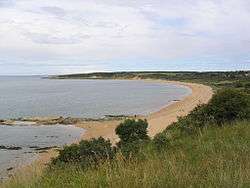John Muir Way
| John Muir Way | |
|---|---|
|
Gullane beach lies on the trail | |
| Length | 215 kilometres (134 mi)[1] |
| Location | Argyll and Bute and East Lothian, Scotland |
| Designation | Proposed Scotland's Great Trail |
| Trailheads |
Helensburgh Esplanade, Helensburgh, Argyll 56°00′11″N 4°44′12″W / 56.0031°N 4.7368°W Dunbar 56°00′09″N 2°30′59″W / 56.0025°N 2.5165°W |
| Use | Hiking and cycling |
| Elevation | |
| Elevation change | 500 m (1,600 ft) |
| Highest point | 500 m (1,600 ft) |
| Lowest point | 0 m (0 ft) |
| Hiking details | |
| Trail difficulty | Easy to moderate |
| Season | All year |
| Sights | Castles, canals , beaches, birds, Roman sites, Falkirk wheel, Kelpies and Helix. |
| Hazards | none |

The John Muir Way is a 215-kilometre (130 mi) continuous long distance route in southern Scotland, running from Helensburgh, Argyll and Bute in the west to Dunbar, East Lothian in the east. It is named in honour of the Scottish conservationist John Muir, who was born in Dunbar in 1838 and became a founder of the United States National Park Service.
The John Muir Way opened on 21 April 2014.[2] Previously a shorter 'John Muir Way' existed only in East Lothian, but now the majority of this older route is now absorbed into the much longer new route. A shorter section of older route from Dunbar to the Scottish Borders will be renamed.
The John Muir Way is signposted throughout using a purple-brown logo.
Along the road is Kelpies, the largest equine sculpture in the world.[3]
Route
Taking the trail from west to east, the John Muir Way starts in Helensburgh, from where he left Scotland for the United States.[4] The trail follows over the hills, providing views of Loch Lomond and the Trossach mountains, before descending into Balloch, with its National Park centre. This is one of the wilder sections of the route with the most rugged terrain: windswept, high moorland with little shelter. From here the route winds its way towards Strathblane and Scotland's most famous long distance walk, the West Highland Way which it crosses near Dumgoyne hill and Glengoyne Distillery.
At Kirkintilloch, the trail picks up the Forth and Clyde Canal and heads through Strathkelvin to Falkirk and its wheel which provides a link between waterways for travelling craft. Roman forts and the Antonine Wall are the next attractions en route to the ancient town of Linlithgow and its impressive palace of Mary Queen of Scots. It leaves Linlithgow with its low lying loch for the seashore and the harbour town of Bo'ness, coasting along to Blackness castle and the bridge town of South Queensferry. The trail follows the greener places in the capital city, Edinburgh, before guiding travellers east, past famous, coastal birding and golf spots via Aberlady and North Berwick. The trail ends in Dunbar, where Muir was born and there is a museum dedicated to him.[4]
Reception
The Independent declared John Muir Way its Walk of the Month for February 2014.[5]
See also
- European long-distance paths
- John Muir Trust
- John Muir's Birthplace
- List of long-distance footpaths
- Sierra Club
References
- ↑ East Lothian information
- ↑ "John Muir Way Opens In April 2014 - Outdoors News". OutdoorsMagic. 2014-02-04. Retrieved 2014-03-20.
- ↑ "Scotland: 10 reasons to come join the clans". Afr.com. Retrieved 2014-03-20.
- 1 2 Miller, David (17 April 2014). "John Muir Way ready to be unveiled". BBC News. BBC. Retrieved 17 April 2014.
- ↑ Mark Rowe (2014-02-22). "Walk of the month: East Lothian coast - Great strides towards conservation - UK - Travel". The Independent. Retrieved 2014-03-20.
External links
- Official website
- John Muir Way on Walkhighlands
- Extended route Helensburgh to Dunbar
- East Lothian Council: The John Muir Way and North Sea Trail
- John Muir Way Baggage Service
Coordinates: 56°02′53″N 2°43′09″W / 56.0481°N 2.7191°W
